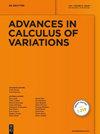系数随时间变化的抛物型方程的Harnack不等式
IF 1.4
3区 数学
Q1 MATHEMATICS
引用次数: 1
摘要
摘要我们定义了一个p=2{p=2}阶齐次De Giorgi类,它包含类型为ξ(x,t)u t+a u=0{\neneneba xi(x,t)u _{t}+Au=0}和(ξ(x,t)u)t+a u=0{。对于属于这一类的函数,我们证明了一个Harnack不等式。作为副产品,可以获得第一个方程的子类解的Hölder连续性。本文章由计算机程序翻译,如有差异,请以英文原文为准。
Harnack inequality for parabolic equations with coefficients depending on time
Abstract We define a homogeneous De Giorgi class of order p = 2 {p=2} that contains the solutions of evolution equations of the types ξ ( x , t ) u t + A u = 0 {\xi(x,t)u_{t}+Au=0} and ( ξ ( x , t ) u ) t + A u = 0 {(\xi(x,t)u)_{t}+Au=0} , where ξ > 0 {\xi>0} almost everywhere and A is a suitable elliptic operator. For functions belonging to this class, we prove a Harnack inequality. As a byproduct, one can obtain Hölder continuity for solutions of a subclass of the first equation.
求助全文
通过发布文献求助,成功后即可免费获取论文全文。
去求助
来源期刊

Advances in Calculus of Variations
MATHEMATICS, APPLIED-MATHEMATICS
CiteScore
3.90
自引率
5.90%
发文量
35
审稿时长
>12 weeks
期刊介绍:
Advances in Calculus of Variations publishes high quality original research focusing on that part of calculus of variation and related applications which combines tools and methods from partial differential equations with geometrical techniques.
 求助内容:
求助内容: 应助结果提醒方式:
应助结果提醒方式:


